|
The recent trend in pistols for self defense has been toward smaller and
lighter. The main factor in this current demand for downsized pistols has
been the proliferation of concealed carry permits around the nation. More states
are now allowing their citizens their right to carry a concealed weapon; a
right that has for too long been denied in many jurisdictions, and continues to be in others.
There is one individual that had a lot to
do with the current demand for smaller handguns in general and pistols in
particular, although that was certainly not his purpose: the dishonorable William
Jefferson Clinton. Had "Slick Willie" not imposed the ban on all private
ownership of newly manufactured magazines with a capacity over ten, we might not have
seen the development of some of the fine pistols which we have available today. Many shooters
believe that if they are limited to a smaller-capacity magazine, they might
just as well carry a smaller handgun.
Glock pistols have been popular in this
country since their introduction here a few years back (See Jeff's
article on the full-sized Glocks at I Hate Glocks). Glock has always
been responsive to consumer demand by providing shooters with what they want,
and in a timely fashion. Glock was quick to respond to the current trend by
offering smaller and lighter pistols than ever before, even though all Glocks
are already some of the best available for concealed carry, especially their
mid-sized models 19, 23, and 32. These Glocks are light, compact, and as smooth as a used bar of soap.
The smallest Glocks are handier still for concealed carry, thus the title
of this article referring to their suitability of being slipped into a pocket for
convenient carry. The title is a bit misleading in this regard, as a good
pocket holster such as offered by Michaels of Oregon is needed to safely carry a Glock in
the pocket. The Sidekick holster is made of nylon and will protect the trigger, while also
keeping the gun in its proper position for drawing in an emergency. If you
need a pistol in the event of an emergency, you need it quick. A gun in the
glove box of the pickup is no good to you if the danger is between you and
the truck. Thus comes into play the chief reason to own a gun for concealed carry; to
have it with you always.
A small, lightweight handgun is more likely to be with you when you need
it than any gun that is neither small nor lightweight. The ideal handgun to have
with you in a gunfight is not a handgun at all, but a powerful rifle or shotgun.
Any handgun of concealable size is a compromise. It is the gun to have with
you when you don't expect trouble. The best thing to do is to avoid trouble in
the first place, but when trouble finds you, the firearm needs to be close and
be ready.
For most people, that means a small but powerful handgun. In this article, we
will discuss two of the best. Glock recently sent me a Model 26 in 9x19mm caliber and a
Model 30, which fires the beloved .45 ACP cartridge. Both of these pistols are scaled-down and
smoothed versions of their larger auto-loading pistols, with just enough
design changes to insure proper functioning within the smaller package.
Each of the Glocks came packaged in a plastic box complete with 2
ten-round magazines, a cleaning rod and brush, a magazine loading tool, detailed
instructions, and a cable lock. The model 26 also included an envelope containing two
fired cartridge cases, for the jurisdictions in which this idiotic practice
is required.
In testing the two pistols, I assembled a
variety of military hardball, premium defense hollowpoints, and various
handloaded ammunition for function testing of the little guns.
I loaded the magazines to capacity with
the aid of the provided loading tool, and fired each gun individually at a six-inch
swinging steel plate at fifteen yards. One of the first things noticed from
both weapons was the apparent lack of expected recoil. Both guns were very
controllable offhand, and even the .45 loaded with 230 grain Federal Hydra-Shok ammo was
no problem in rapid fire drills at the steel plate. The weight of the models
26 and 30 are 21.75 and 26.5 ounces, respectively, each with an empty magazine. The felt recoil with the
light .45 was no more than my all-steel 1911A1 Colt. The design of the Glocks
provides for a low bore axis, and really helps reduce the muzzle rise during
recoil.
In the course of firing both guns, no
failures of any kind were detected. Each pistol fed, fired, and ejected every
round with 100 percent reliability. At the end if each firing string, the slides
locked back on an empty magazine. I was not surprised by this degree of reliability, as this is what I have come to
expect from Glock. The only failures that I have witnessed over the years with Glock pistols have been shooter
induced, or due to low quality ammunition.
These smallest of Glock pistols, and particularly the 9mm model 26, is
about as small and light as possible with a pistol that can reliably fire full power
defense ammo. Both would also be ideal as a second carry gun to a larger Glock in the
same caliber. In that sense, if the primary weapon failed or was taken, the
smaller Glock could even use the same magazines as the larger gun.
As shown in the photos, the model 26 is not a lot larger than my .32 Kel-Tec
(See Jeff's article on the .32 Kel-Tec at Kel-Tec .32 Auto),
but has far superior firepower. In all reality, the Kel-Tec is more of a weapon to be carried in addition to a
more powerful handgun. The Kel-Tec would make a great backup gun to the
Glock, as both share the same method of firing, which is simply draw the weapon, aim, and pull the trigger.
The design is not encumbered by safety levers, but the safeties are built into the
design. The gun will not fire unless the trigger is pulled.
Overall, I was very impressed by the two pistols tested. They do not, to
me at least, stir the soul like a fine single-action sixgun made of blued steel and walnut. They have no
provision for attaching a fine set of carved ivory grips. They do, however,
have a quality that endears these guns to people who choose to go heeled in
places of possible danger: that being the ability to rapidly and repeatedly
deliver fight-stopping power in a relatively compact and lightweight
sidearm. These are the same qualities that endeared the old Colt single-action
to those who carried a handgun well over one hundred years ago.
If you, like many people today, have the
need or desire to go armed, and want a concealable handgun without having to
compromise on stopping power, try one of these smaller guns from Glock. They
are light, durable, reliable, and carry eleven rounds of 9mm or .45 ACP, counting the one in the chamber.
Glocks are built in a state-of-the-art factory in Austria from high
quality materials. Glock distribution is handled in North America by Glock, Inc. in
Smyrna, Georgia and can be reached by phone at: (770) 432-1202 or on the
web at: www.glock.com
In Europe, Africa, and the Middle East call: 43-2247-90300.
In Asia and Australia call: 852-2375-3858.
In Central and Latin America call: 598-2 902-22-27.
Jeff Quinn
  
Got something to say about this article? Want to agree (or
disagree) with it? Click the following link to go to the GUNBlast Feedback Page.
All content © 2001 GunBlast.com. All rights
reserved.
|
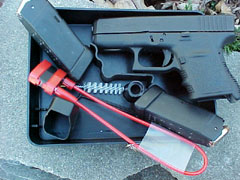
Glock Model 30 with included accoutrements.
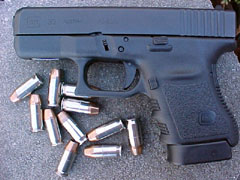
Glock Model 30 with a full payload of eleven rounds of Federal's
excellent Hydra-Shok ammunition.
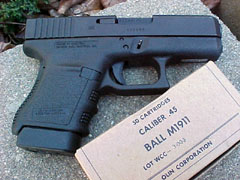
Glock Model 30 shown with a box of .45 ACP hardball ammunition. This
little .45 is barely bigger than a box of its ammo!
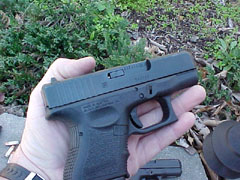
Glock Model 26 in author's hand shows the small size of this pint-sized
powerhouse.
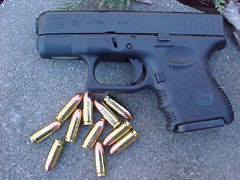
Glock Model 26 with eleven rounds of hardball ammunition.
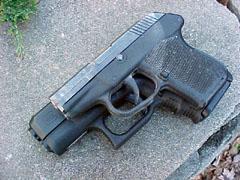
Author's Kel-Tec .32 shown for size comparison along with the Glock
Model 26. The Kel-Tec, which is highly regarded as one of the smallest
.32s available, is not much smaller than the tiny 9mm Glock!
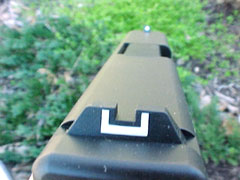
Glock is known for the quality and easy acquisition of its sights, and
the little Model 26 and Model 30 (shown) are no exceptions!
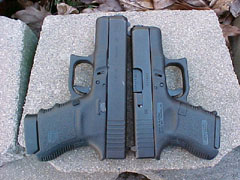
On the left is the Glock Model 30 in .45 ACP, on the right is the Glock
Model 26 in 9mm Parabellum.
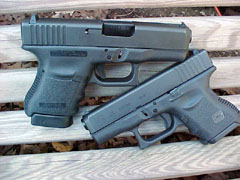
Glock Model 30 (top), Model 26 (bottom).
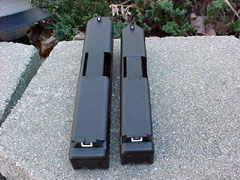
Comparison of the slides of the Model 30 (left) and the Model 26
(right). Both models are about as small as they can be for practical use
in their respective calibers.

Double recoil spring system of the Model 30 (top) and Model 26
(bottom).
|
![]()